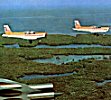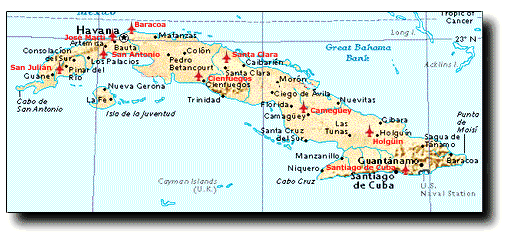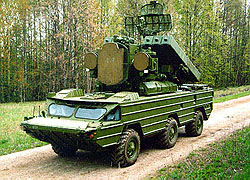

The Cuban Air Force Today. EquipmentRuben Urribarres |
 In the XX century the Cuban Air Force received some 1,100 aircrafts, of them some
440 until 1958 and 660 after 1959.
In the XX century the Cuban Air Force received some 1,100 aircrafts, of them some
440 until 1958 and 660 after 1959.
Among the combat fighter received were the MiG-21 versions F-13, PF, PFM, PFMA, MF, R, Bis; and the versions U, US and UM for training. Of all of them, only half a dozen devices remain active today. Were also received MiG-23 of the versions MF, ML, BN and UB. Finally were received 8 MiG-29, that were the last combat aircraft received by the FAR, and are the best of Latin America in close combat at that moment. .
By 1990 Cuba had in service about 172 fighter jets, of which:
- 8 fighters MiG-29 basic versions and two-seats UB
- 58 fighters MiG-23 from versions BN, ML y UB
- 106 fighters MiG-21 from versions Bis, MF, PFMA y UM
| Regimiento de Caza / Base Aérea de San Antonio de los Baños Escuadrón de Caza, with 5 MiG-29, 3 MiG-29UB (Air Defense/Attack) Escuadrón de Caza, with 12 MiG-23ML, 4 MiG-23UB (Air Defense/Attack) Escuadrón de Intercepción, with 12 MiG-21bis, 2 MiG-21UM (Air Defense/Attack) Escuela Militar para Pilotos Aereos (EMPA) (Air Training Command) Escuela de Aviacion Militar Comandante Che Guevara / Base aérea de San Julián Escuadrón de Enseñansa de Vuelo Avanzado, with 12 MiG-21UM (Combat Training) Escuadrón de Enseñansa de Preparacion Combativa, with 12 MiG-21PFMA (Combat Training) Escuadrón de Enseñansa de Preparacion Combativa, with 12 MiG-21MF (Combat Training) |
| Regimiento de Caza / Base aérea de Santa Clara Escuadrón de Cazabombardeo, with 12 MiG-23BN, 2 MiG-23UB (Attack) Escuadrón de Cazabombardeo, with 12 MiG-23BN, 2 MiG-23UB (Attack) Escuadrón de Intercepción, with 12 MiG-21bis, 2 MiG-21UM (Air Defense/Attack) Escuadrón de Intercepción, with 12 MiG-21bis, 2 MiG-21UM (Air Defense/Attack) |
| Regimiento de Caza / Base aérea de Holguín Escuadrón de Caza, with 12 MiG-23ML, 2 MiG-23UB (Air Defense/Attack) Escuadrón de Intercepción, with 12 MiG-21bis, 2 MiG-21UM (Air Defense/Attack) Escuadrón de Intercepción, with 12 MiG-21bis, 2 MiG-21UM (Air Defense/Attack) |
With the end of the Cold War and the normalization of relations with the United States, the need for such an air fleet, which exceeds the needs of Cuba's national defense, disappears.
This factor, coupled with the natural wear and tear of the aeronautical technique, the decrease in the supply of spare parts by Russia and the lack of resources of the country to maintain such a fleet, allowed most of these equipment to be deregistered and to save resources.
The best-fit equipment was put into conservation. The most obsolete and worn equipment, with no chance of returning to the air, was caught for pieces or placed in museums and parks. Others just scrapped. Everything like every other air force in the world.
Of all these fighters, today (year 2020) remain active only half a dozen MiG-21bis and MiG-21UM.
Thus, being the FAR the Air Force with more combat aircraft of Latin America in the 80s, today it is again an Air Force with the magnitudes of its Latin American and Caribbean neighbors.
| Air to air: R-13 (AA-2 Atoll), R-24R/T (AA-7 Apex), R-60M (AA-8 Aphid), R-27 (AA-10 Alamo). Air to surface: X-23 (AS-7 Kerry) |  |
 The Revolutionary Navy had helicopters Mi-14 and Ka-29 in antisubmarine warfare and
SAR. The Ministry of the Interior (MININT) is a independent of the FAR corp, to
the one that belong the National Revolutionary Police (PNR) and the Border Guard
Troops (TG). The PNR has helicopters Mi-2 for the interior order, and the TG has Czech airplanes Z-142 for coasts patrol. All these aircrafts are writed off today.
The Revolutionary Navy had helicopters Mi-14 and Ka-29 in antisubmarine warfare and
SAR. The Ministry of the Interior (MININT) is a independent of the FAR corp, to
the one that belong the National Revolutionary Police (PNR) and the Border Guard
Troops (TG). The PNR has helicopters Mi-2 for the interior order, and the TG has Czech airplanes Z-142 for coasts patrol. All these aircrafts are writed off today.
![]() Civil Aviation
Civil Aviation  The
Cuban civil airplanes are reserve of the FAR, can be employees in case of need. For example, like the
heavy transport Il-76 or the photo reconnaisance An-30.
By 1990 these enterprices had some 175 aircrafts:
The
Cuban civil airplanes are reserve of the FAR, can be employees in case of need. For example, like the
heavy transport Il-76 or the photo reconnaisance An-30.
By 1990 these enterprices had some 175 aircrafts:
| Cubana de Aviación | Aerogaviota | Aerocaribbean | Aerotaxi |
| 10 Antonov An-24RV
20 Antonov An-26 2 Airbus A320 (TACA 9 Ilyushin Il-62M 2 Ilyushin Il-76MD 4 Tupolev Tu-154M 6 Yakovlev Yak-40 3 Yakovlev Yak-42D 3 Douglas DC-10-30 5 Mil Mi-8 |
3 ATR-42-300 1 ATR-72 15 Mil Mi-8 1 Antonov An-2 21 Antonov An-26 1 Antonov An-30 4 Yakovlev Yak-40 | 1
Antonov An-24 3 Antonov An-26 3 ATR-42-300 1 ATR-72 1 Ilyushin Il-14 3 Ilyushin Il-18 3 Yakovlev Yak-40 | 41
Antonov An-2 4 Douglas DC-3 5 Mil Mi-8 |
| Eastern San Antonio de los Baños, San Julián, Ciudad Libertad, Baracoa, Mariel, Varadero Center Santa Clara, Cienfuegos East Santiago de Cuba, Holguín, Camaguey |
 . .
Air bases. Picture from the Air Power Journal |
| from 3,660 m or more: 3; | from 3,047 to 3,660 m: 7; | from 2,438 to 3,660 m: 12; |
| from 1,524 to 2,437 m: 14; | from 914 to 1,523 m: 11; | from 914 m or less: 36. |
| The DAAFAR has 4 Brigades with 28 Battalions of S-125 and S-75 missiles, that defending cities, air bases, and other objectives. The Army have an important quantity of anti aircraft artillery. These troops shoot down various aircrafts during the combats by Bay of Pigs, and in Angola, where they efficiently defending the ground troops from the enemy attacks. During the Missiles Crisis of October of 1962, the missiles S-75 shoot down over Cuba an USAF spy plane Lockheed U-2. |  |
| Surface to air Missiles | Army Anti Aircraft Artillery |
| DAAFAR: 144 S-75 Dvina (SA-2 Guideline) 48 S-125 Neva (SA-3 Goa) Army: 12 9M9 Kvadrat (SA-6 Gainful) ? 9K33 Osa (SA-8 Gecko) 60 S-1M Strela-1 (SA-9 Gaskin) 40 9K35 Strela-10 (SA-13 Gopher) ? 9M32 Strela-2 (SA-7 Grail) ? 9K34 Strela-3 (SA-14 Gremlin) | ? ZPU-1,-2,-4
(1x, 2x, 4x 14,5mm) 400 ZU-23-2 (2 x 23mm) 100 M53 (2 x 30mm, some in a BTR-60P) 300 M1939 (37mm) 200 S-60 (57mm) 100 KS-12 (85mm) 75 KS-19 (100mm) Self propelled gun: 36 ZSU-23-4 Shilka (4 x 23) 25 SU-57-2 (2 x 57mm) |
Most of these equipment, are also writed off today.
|
|
|
|
|||

